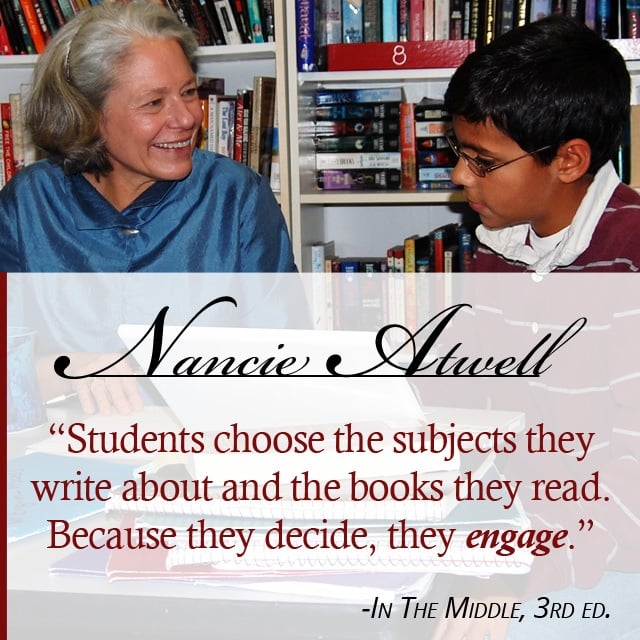With our In The Middle Wednesday series, Nancie Atwell gives us a guided tour of the third edition of In the Middle.
With our In The Middle Wednesday series, Nancie Atwell gives us a guided tour of the third edition of In the Middle.
Nancie, you give us so many ideas and lessons in this book. It’s less a revision than a brand new teaching resource. What things stand out as different and significant?
Response written by Nancie Atwell
 I guess I’d start with the soup-to-nuts genre studies that make up the second half of the book. I organize my writing workshop across a school year as a series of genre studies. These include free-verse poetry, various poetic forms, memoirs, reviews, microfiction, essays, advocacy journalism, profiles, parodies, and homages (poems written under the influence of other poets). I detail what happens day to day in each genre study, from the launch to the culminating activity, which is some form of publication. And I include new examples of student work for other teachers to use as models with their kids.
I guess I’d start with the soup-to-nuts genre studies that make up the second half of the book. I organize my writing workshop across a school year as a series of genre studies. These include free-verse poetry, various poetic forms, memoirs, reviews, microfiction, essays, advocacy journalism, profiles, parodies, and homages (poems written under the influence of other poets). I detail what happens day to day in each genre study, from the launch to the culminating activity, which is some form of publication. And I include new examples of student work for other teachers to use as models with their kids.
In each exploration of a particular kind of writing, my students and I begin by analyzing strong pieces from the genre and teasing out their features. I can’t say enough about how effective this is. Kids own these standards and attempt to write toward them from the inside, in contrast with rubrics or traits developed and imposed from on high.
I think asking students to articulate genre features will be a huge help to teachers of large classes, who find it difficult to confer frequently enough with individual writers. Students who become knowledgeable about the features of a genre not only are more self-critical as writers but also can give their classmates informed responses in peer conferences. When there isn’t enough teacher to go around, we can train kids, genre to genre, to become smart readers of their own and others’ drafts.
The chapter about writing conferences is also new. I tried to relieve some of the tension teachers feel about conference orthodoxies, about the “right” and “wrong” things to do. I share my guidelines, transcripts of many conversations with students, and a dozen or so red flags I’ve observed in pieces of student writing that aren’t working yet. I think teachers will find the red flags especially useful as they try to put their finger on what’s not working in their students’ drafts and then offer their kids effective solutions.
 For example, a narrative written in the first-person-plural voice always creates problems. When a writer casts a story as “we did this, and then we did that,” she can’t reflect—can’t tell us her thoughts and feelings. This means two things: a reader has no one to be with in the story (and will most likely be bored by it), and the writer will struggle to develop a theme, since theme most often grows from personal reflections. One helpful conference response is a nudge to change the voice to I; a second is to remind the writer to follow “the rule of thoughts and feelings.”
For example, a narrative written in the first-person-plural voice always creates problems. When a writer casts a story as “we did this, and then we did that,” she can’t reflect—can’t tell us her thoughts and feelings. This means two things: a reader has no one to be with in the story (and will most likely be bored by it), and the writer will struggle to develop a theme, since theme most often grows from personal reflections. One helpful conference response is a nudge to change the voice to I; a second is to remind the writer to follow “the rule of thoughts and feelings.”
I packed the book with essential craft minilessons, like the one about thoughts and feelings, that address principles of literary writing, but in language kids can understand. Craft lessons to the whole group become points of reference in my conferences with individual writers, where I can cut to the chase: “Where are your t and f?” “What’s the so what?” “Is this pebbles instead of a pebble?” This shorthand also keeps my conferences briefer, so I get to meet with more writers during each workshop.
There’s also a new genre in ITM III, one I call the “letter-essay,” which is a substitute for the weekly correspondence I used to exchange with student readers. Today, students write long letters every three weeks, to me or a classmate, about books they have finished reading. They analyze an author’s choices and select a representative passage to annotate. While a letter-essay is a sustained critique, it’s still informal: a first-draft consideration of a work of literature. Letter-essays are a strong jumping-off point for the lit crit my students compose in their high school and college English courses. I’ve included examples of students’ letter-essays, replies from me and peers, and the guidelines and criteria my kids and I established for these close readings of books.
Our daily poem is another practice that calls for close reading. For years I’ve started each workshop by distributing a poem and asking my classes to discuss it—to analyze diction, form, tone, structure, theme, figurative language, title, turn, conclusion. My teaching anthology Naming the World: A Year of Poems and Lessons collects the poetry my kids nominated as the best of the best, along with my ideas for teaching it. Since students in a workshop are reading different books, the daily poem gives us an opportunity to focus together for ten minutes on one literary text without robbing them of their independence as readers, not to mention eating up class time that should be devoted to practicing reading.
The new edition is rich with other practical matters: guidelines for book talks and peer writing conferences;–how I organize the classroom library and keep track of books; sample substitute plans for a writing–reading workshop; all the record-keeping forms the kids and I use; a spelling program that actually works; more than 200 new pieces of student writing to be reproduced as mentor texts; my two-year curriculum sequence; the uses and format of the writing–reading handbook; and a discussion and examples of an essential step in the writing process, one my kids and I call “writing off the page,” which has transformed both their fluency as writers and their ability to craft literature.
I’m excited to learn what other teachers will make of it all. I worked hard to make things easier, richer, more sensible, and more satisfying, for them and for their students, too.
This blog post is part of In the Middle Wednesdays series. Please visit http://www.heinemann.com/InTheMiddle to learn more.


